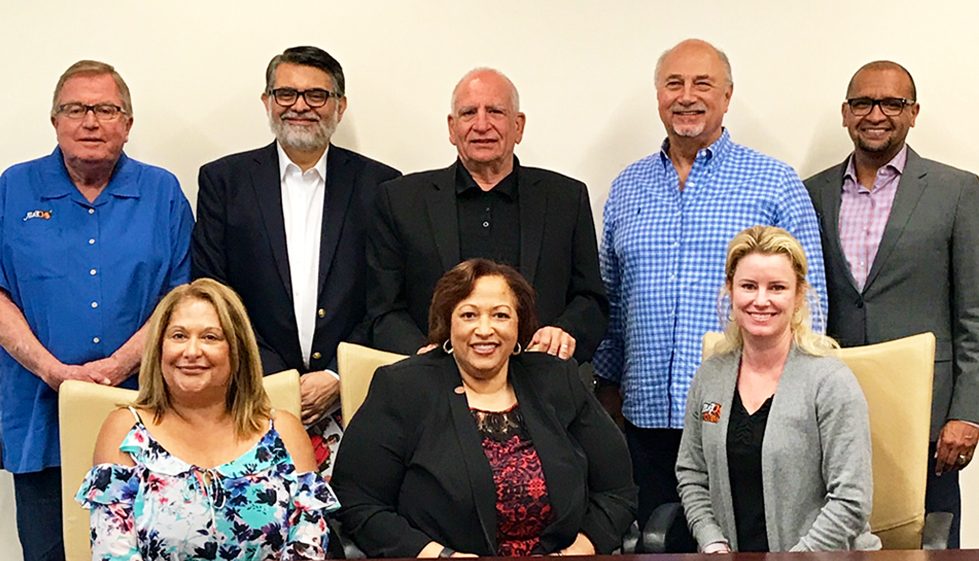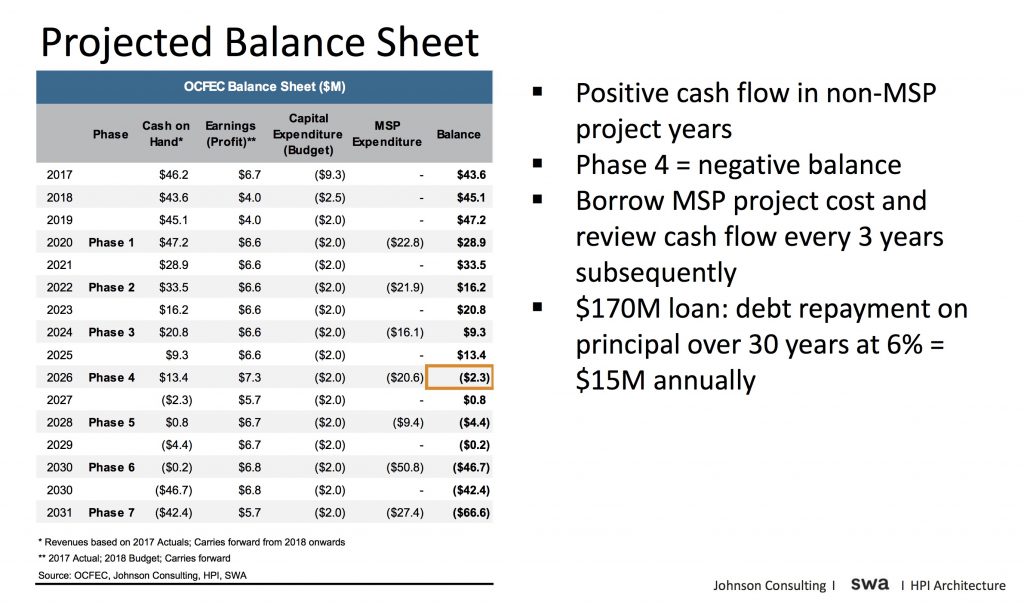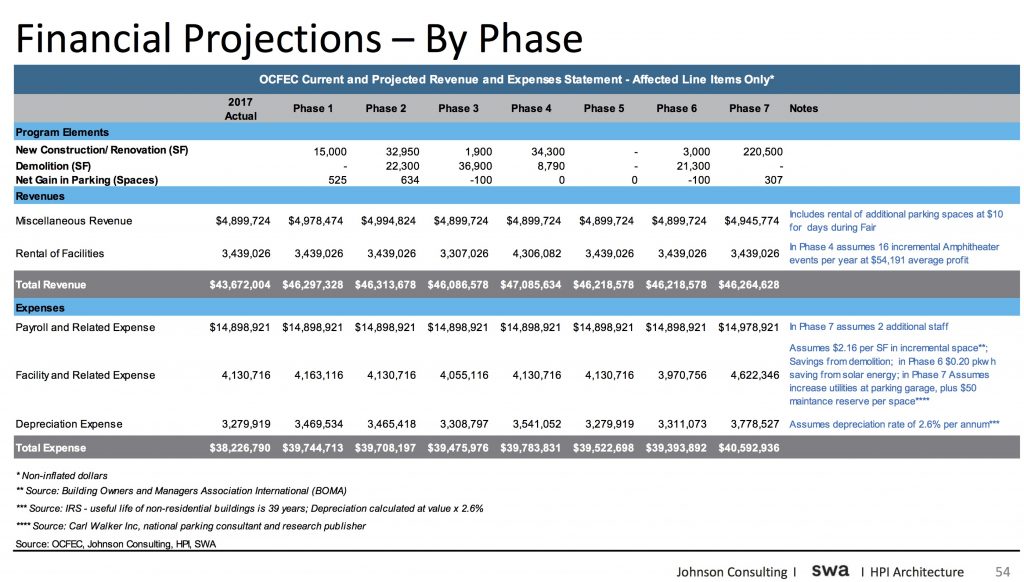.
.
.
by Reggie Mundekis, cross-posted from the “Fans of the OC Fairgrounds” blog.
 A Master Site Plan proposal for the OC Fairgrounds (also called Orange County Fair and Event Center or OCFEC) created by a team of Johnson Consulting, HPI Architecture, and landscape architects SWA relies upon a $170 million bond issue to fund projects including doubling the size of the Administration Building, moving the Main Entrance about 200 ft closer to the 55 Freeway, demolishing the Equestrian Center, and reviving a parking garage next to a residential neighborhood cancelled in 2015 after loud neighborhood opposition, among other changes. The $170 million bond funding proposal was glossed over in two slides which are deficient in material facts, to put it charitably. As you consider these matters, remember that over a quarter of a million dollars has been paid to the consultants to create this work product in addition to countless hours of staff and Board Directors involved with the Master Site Plan process.
A Master Site Plan proposal for the OC Fairgrounds (also called Orange County Fair and Event Center or OCFEC) created by a team of Johnson Consulting, HPI Architecture, and landscape architects SWA relies upon a $170 million bond issue to fund projects including doubling the size of the Administration Building, moving the Main Entrance about 200 ft closer to the 55 Freeway, demolishing the Equestrian Center, and reviving a parking garage next to a residential neighborhood cancelled in 2015 after loud neighborhood opposition, among other changes. The $170 million bond funding proposal was glossed over in two slides which are deficient in material facts, to put it charitably. As you consider these matters, remember that over a quarter of a million dollars has been paid to the consultants to create this work product in addition to countless hours of staff and Board Directors involved with the Master Site Plan process.

OCFEC was founded in 1949 by a grant of land from the former Santa Ana Army Air Base (SAAAB) for use as a public park, fairground, and recreation. Download the deed and most recent title report
Since 1949, construction has been financed without going into debt. This has allowed OCFEC to weather economic problems better than other fairgrounds. For unknown and unclear reasons, Johnson Consulting, HPI Architecture, and SWA propose a high priced set of projects of little real value which could bankrupt OCFEC or force a major change in operations while causing long term and irreversible harm to the surrounding residential neighborhoods. This process cost over a quarter of a million dollars in consultant fees, uncounted staff time, and took over a year to conduct. More scrutiny is needed of what has transpired before the Master Site Plan process can move ahead.
The two slides about bond finacing presented by Johnson Consulting, HPI Architecture and SWA follow and can be downloaded here Download Financials_CHJC-OCFEC-Board-Presentation-April-2018
*
*
1. Bond Payments are Missing from the Financial Projections
 The phased build out of the Master Site Plan proposal takes more than a decade and relies on $170 million in bond financing. No analysis of the impacts of bond financing or supporting information is presented in the April 2018 proposal. The hard consequences of the massive debt issue are ignored, at the most charitable. Payments for the bonds are missing from the financial projections prepared by the consultants. Estimated payments on a one time capital infusion of $170 million at 6% is about $15 million per year for 30 years. Johnson Consulting, HPI Architecture, and SWA slides show project phases being paid for and revenues generated by the phases but do not show the $15 million per year deduction needed to pay for the $170 million in bond debt.
The phased build out of the Master Site Plan proposal takes more than a decade and relies on $170 million in bond financing. No analysis of the impacts of bond financing or supporting information is presented in the April 2018 proposal. The hard consequences of the massive debt issue are ignored, at the most charitable. Payments for the bonds are missing from the financial projections prepared by the consultants. Estimated payments on a one time capital infusion of $170 million at 6% is about $15 million per year for 30 years. Johnson Consulting, HPI Architecture, and SWA slides show project phases being paid for and revenues generated by the phases but do not show the $15 million per year deduction needed to pay for the $170 million in bond debt.
When asked about this during the April 2018 Board meeting, representatives from Johnson Consulting seemed surprised that this was an issue.
2. Nearly Half a Billion Dollars Paid Out to Build What Amounts to Parking Lots
 Interest more than doubles the $170 million bond to $450 million (30 years X $15 million/year = $450 million).
Interest more than doubles the $170 million bond to $450 million (30 years X $15 million/year = $450 million).
Paying nearly half a billion dollars to build what amounts to a few more parking places is insane. This proposal was a non-starter and should have been shredded instead of being brought forward.
.
3. Project Locked In & Cannot Be Changed Under Bond Financing
Bond financing locks in a project once the bonds are underwritten. The underwriting process sets the cash flows which must be obtained to maintain solvency and to meet debt covenants entered into as part of the bond underwriting process. It is difficult if not impossible to change a project once the bonds are sold. A future Board would face a high if not impossible hurdle to changing a project funded by bonds. Representatives from Johnson Consulting did not mention this during the April 2018 Board meeting and it is not clear if OCFEC Directors understand that bond financing locks in a project.
4. No Good Choices Come from $170 Million in Bonds: Either Bankrupt OCFEC or Quadruple Annual Revenues to Pay Debt Service
 Annual payments on the $170 million bond issue are $15 million per year for 30 years at 6%. Each and every year a $15 million check needs to be written to pay off the debt of building what amounts to parking lots. Current OCFEC operations have revenues of around $45 million per year and around 10% in net proceeds in 2017 which is about $4.5 million. How is that going to pencil out?
Annual payments on the $170 million bond issue are $15 million per year for 30 years at 6%. Each and every year a $15 million check needs to be written to pay off the debt of building what amounts to parking lots. Current OCFEC operations have revenues of around $45 million per year and around 10% in net proceeds in 2017 which is about $4.5 million. How is that going to pencil out?
Choose to Declare Bankruptcy: Once the $15 million annual debt payment starts, current reserves of about $45 million only last a few years until an over $10 million deficit occurs each year because the $4.5 million in annual net proceeds is not enough to pay the $15 million in debt payment. At that point, OCFEC faces long term insolvency of their own making. A private company could declare bankruptcy to restructure the debt but it is not clear what happens to a state agency which becomes bankrupt caused by actions of the state agency.
Choose to Quadruple Annual Revenues to Avoid Bankruptcy: Quadrupling annual revenues from $45 million to about $180 million can produce annual net proceeds of $18 million, if everything goes just right. Annual revenues of $180 million pay the annual debt bill due but do not provide enough cash flow to re-build depleted cash reserves. Going to five (5) times annual revenues which is about $225 million per year allows debt to be paid and reserves to be re-built.
 Achieving annual revenues of at least $180 million will bring heavy year round use of OCFEC such as that experienced by the residential neighborhoods during the annual OC Fair. Traffic will clog public streets, lights and noise will continue into the night every night of the year and it is unclear if the drive to book events for the sake of booking events will be kicked into hyperdrive to make more money to stay solvent. Who knows what events will be booked to make at least $180 million a year in revenues.
Achieving annual revenues of at least $180 million will bring heavy year round use of OCFEC such as that experienced by the residential neighborhoods during the annual OC Fair. Traffic will clog public streets, lights and noise will continue into the night every night of the year and it is unclear if the drive to book events for the sake of booking events will be kicked into hyperdrive to make more money to stay solvent. Who knows what events will be booked to make at least $180 million a year in revenues.
The current buildings may not be enough to bring in $180 million in annual revenues. New buildings may be needed to have more events to make the minimum required $180 million in annual revenue. New buildings will need new debt financing because OCFEC does not have significant reserves at this time because OCFEC is barely keeping up with what they owe. More debt needs more revenue and the debt death spiral of OCFEC becomes obvious. OCFEC destroys College Park, Mesa del Mar, and Vanguard neighborhoods along with themselves with self-created problems arising from their greed.
Johnson Consulting, HPI and SWA did not discuss the financially destructive nature of the proposal brought forward by their firms. The Public is owed answers from Johnson Consulting, HPI and SWA regarding these matters.
5. Bond Financing Proposal Shows Why Audits of Fairgrounds Operations are Needed
 The April 2018 Master Site Plan should have never seen the light of day and was treated like a homework assignment that had to be handed in to be checked off in a grade book. Consultants and staff handed in their homework and expected a star sticker in return but were met with well earbed negative responses and hard questions regarding the plans. Over a quarter of a million dollars has been paid to consultants who did not seem to notice that their proposal would offer OCFEC a choice between bankruptcy or destroying OCFEC along with the quality of life in the surrounding neighborhoods. Board Directors who wanted to press forward on the Master Site Plan process without having a workable, buildable plan which is supported by the Public in hand are not serving the interests of the Public who own OCFEC and whom the Directors represent.
The April 2018 Master Site Plan should have never seen the light of day and was treated like a homework assignment that had to be handed in to be checked off in a grade book. Consultants and staff handed in their homework and expected a star sticker in return but were met with well earbed negative responses and hard questions regarding the plans. Over a quarter of a million dollars has been paid to consultants who did not seem to notice that their proposal would offer OCFEC a choice between bankruptcy or destroying OCFEC along with the quality of life in the surrounding neighborhoods. Board Directors who wanted to press forward on the Master Site Plan process without having a workable, buildable plan which is supported by the Public in hand are not serving the interests of the Public who own OCFEC and whom the Directors represent.
A Board Director who touts her financial credentials did not question the impact of the bond payments on OCFEC solvency and wanted to hurry the process along for the sake of moving things along. A Director such as this is not needed and may find themselves to be happier outside the scrutiny of the Public and with more free time to use as they choose. We thank you for your service and wish you well on your future endeavors.
6. What Needs to Happen to Regain Public Trust
Work on the Master Site Plan needs to stop. An audit of the Master Site Plan process is needed to find out where the money went, how two sets of Master Site Plan proposals which were not acceptable to the Public and destroy the nature of OCFEC were brought forward and who could benefit from these proposal, among other questions to be answered.
The Voice of OC has joined Director Nick Berardino in calling for a performance auditor to be hired at OCFEC to aid in staff oversight. Empowering a performance auditor is supported. Hiring a performance auditor is money well spent and needs to happen as soon as possible.

Contact Information to Follow Up on Issues
Contact the Fair Board
Chair Barbara Bagneris bbagneris@ocfairboard.com
Vice Chair Robert Ruiz rruiz@ocfairboard.com
Newton Pham npham@ocfairboard.com
Sandra Cervantes scervantes@ocfairboard.com
Stan Tkaczyk stkaczyk@ocfairboard.com
Doug La Belle dlabelle@ocfairboard.com
Gerardo Mouet gmouet@ocfairboard.com
Ashleigh Aitken aaitken@ocfairboard.com
Nick Berardino nberardino@ocfairboard.com
Contact CEO Kathy Kramer kramer@ocfair.com
Contact VP of Operations Ken Karns kkarns@ocfair.com
Contact the Governor’s Appointments Secretary Mona Pasquil Rogers at mona.pasquil@gov.ca.gov to discuss OCFEC Director performance issues. Fair Board Directors are appointed by the Governor and may be removed for cause by the Governor at any time. (Cal. Food & Agriculture Code § 3959-3960.)
Contact Parent State Agency OCFEC is a state agency under the California Department of Food and Agriculture (CDFA) because OCFEC is a state run county fair created to support California agriculture. Please refer to as OCFEC as the 32nd District Agricultural Association (32nd DAA) when dealing with the state.
CDFA Secretary Karen Ross 916-654-0433 secretary.ross@cdfa.ca.gov
Fairs and Exhibitions (F&E) are under the Marketing Services Division.
F&E Branch Chief John Quiroz 916-900-5025 john.quiroz@cdfa.ca.gov










A mega fairgrounds means –
More noise More traffic More pressure on the Costa Mesa infrastructure More pollution
Paid for by public funds?
This is a bad idea, where does it come from or who?
Having read not only this but earlier pieces by Fairgrounds watchdog Reggie, it seems like it comes from the high-level Fairgrounds staff like the CEO, who are not getting any resistance from the Board of Directors who SHOULD be paying more attention, questioning them more, sometimes saying no.
Good news at the end of the story sounds like the Board is just STARTING to do a little of that, probably mainly from Reggie’s prodding. You should take advantage of some of those e-mail links she provided and let them know what you think. As so often, public apathy is the biggest problem.
Seems like the title of “Biggest Problem” is a neck and neck race between Public Apathy and Fair Board Director Apathy. What is the public stance on (if any), and voting support record for, this plan, from Fair Board Member ( and prospective Anaheim Mayoral hopeful) Ashleigh Aitken ?
I seem to remember a few months back, news of a “Monument to Farm Labor” or something similar, becoming a structural disaster and financial sinkhole after Board approval having more enthusiasm than scrutiny. Is this another point on the same curve, and just HOW LONG is that curve ?
PS – GREAT choice of thumbnail animations ! Perhaps one will be a new Fair Board logo? Thanks, Reggie M, for your vigilance!
Speaking of tone deaf: Aitken is bragging on her website about that stupid farm labor monument, a project that started out costing $90,000 and then needed $260,000 more to “repair.” And there you have the typical liberal mindset: it doesn’t care how much it cost, or how badly you got swindled so long as your heart was in the right place.
Fairgrounds staff make it hard for the Public to participate. Fair Board meetings are held once a month on Thursday at 9 am. The meetings are not streamed or recorded. Agenda packets prepared by staff have as little usable info in them as staff can get away with.
Fairgrounds staff do not write staff reports like city staff write but rely on slide shows without any support or back up for statements made. Questions to Fairgrounds staff as simple as “how did you get these numbers and can I have the backup” are met with being ignored at best or a blank stare before the staffer takes a hike, or harassment from other staff and Board Directors.
Great questions! Fairgrounds management want more money for the sake of more money. I don’t understand why the Fairgrounds can’t be run more like a park with revenue generators like the OC Fair and year round events used to support public programming and use.
As the fairgrounds is surrounded by homes the problem is evident in the past mistakes.
In other words, if you build it they will sue, as happened with the Amphitheater. Then all the millions will just be gone for nothing?
You bring up a good point. The Fairgrounds creates their own problems because staff and some Board Directors refuse to acknowledge that the Fairgrounds has to be compatible with the neighborhoods around the property. The Fairgrounds must fit into the neighborhoods, the neighborhoods don’t bend to fit around the Fairgrounds. Staff and some Directors such as Sandra Cervantes from Irvine don’t want people telling them what they can and can’t do.